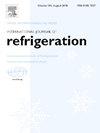Novel concept of magnetocaloric heat pipe and its micro-unit regeneration cycle
IF 3.5
2区 工程技术
Q1 ENGINEERING, MECHANICAL
International Journal of Refrigeration-revue Internationale Du Froid
Pub Date : 2025-03-17
DOI:10.1016/j.ijrefrig.2025.03.024
引用次数: 0
Abstract
Magnetocaloric Refrigeration (MR) presents a viable alternative to the Vapor Compression Cycle (VCC). The Active Magnetic Regenerator (AMR) has thus far been hindered by challenges related to low operational frequencies and inadequate heat transfer coefficients. The Micro-Unit Regeneration (MUR) cycle demonstrates nearly flawless performance within the caloric thermodynamic cycle, but its fully solid-state prototype suffers from extremely low thermal conductivity, rendering it impractical for real-world applications. This paper introduces a novel concept of Magnetocaloric Heat Pipe (MCHP). It integrates Magnetocaloric Effect (MCE) with phase change heat transfer to enhance heat transfer efficiency between Magnetocaloric Materials (MCMs). A MCHP-MUR cycle for magnetic heat pump is developed, a small temperature difference between micro-unit of MCMs drives the evaporation-condensation phase change heat regeneration. Additionally, a thermal resistance model of the MCHP unit and multi-stage MUR cycle are constructed for performance evaluation at 1.5 T magnetic intensity. Experimental results indicate that the heat transfer process, characterized by a small temperature difference of 4.0 K, can be completed and reach equilibrium within 0.5 s, which is a 99 % reduction in equilibrium time compared to solid-state heat conduction. A system temperature span of 3.2 K was attained in basic two-stage MCHP-MUR cycle. In numerical simulations, a dual 16-stage MCHP-MUR cycle demonstrated a maximum no-load temperature span of 25.3 K and a peak heating capacity of 3.5 W g-1 at zero temperature span. The paper also offers recommendations and discussions that may inform the design and optimization of the innovative MCHP-MUR cycle.
磁热管及其微单元再生循环的新概念
磁热制冷(MR)提出了一个可行的替代蒸汽压缩循环(VCC)。迄今为止,有源磁再生器(AMR)一直受到低工作频率和传热系数不足等挑战的阻碍。微单元再生(MUR)循环在热热力学循环中表现出近乎完美的性能,但其全固态原型的导热系数极低,使其在实际应用中不切实际。本文介绍了磁热管(MCHP)的新概念。它将磁热效应(MCE)与相变传热相结合,提高了磁热材料(mcm)之间的传热效率。研制了一种磁力热泵MCHP-MUR循环,利用mcm微单元间的微小温差驱动蒸发-冷凝相变热再生。此外,还建立了MCHP机组和多级MUR循环的热阻模型,对其在1.5 T磁场强度下的性能进行了评价。实验结果表明,该传热过程在0.5 s内完成并达到平衡,传热温差较小,仅为4.0 K,与固态导热相比,传热平衡时间缩短了99%。在基本两段式MCHP-MUR循环中,系统温度范围达到3.2 K。在数值模拟中,双16级MCHP-MUR循环显示出最大空载温度范围为25.3 K,零温度范围下的峰值加热能力为3.5 W g-1。本文还提出了建议和讨论,可能为创新的MCHP-MUR循环的设计和优化提供信息。
本文章由计算机程序翻译,如有差异,请以英文原文为准。
求助全文
约1分钟内获得全文
求助全文
来源期刊
CiteScore
7.30
自引率
12.80%
发文量
363
审稿时长
3.7 months
期刊介绍:
The International Journal of Refrigeration is published for the International Institute of Refrigeration (IIR) by Elsevier. It is essential reading for all those wishing to keep abreast of research and industrial news in refrigeration, air conditioning and associated fields. This is particularly important in these times of rapid introduction of alternative refrigerants and the emergence of new technology. The journal has published special issues on alternative refrigerants and novel topics in the field of boiling, condensation, heat pumps, food refrigeration, carbon dioxide, ammonia, hydrocarbons, magnetic refrigeration at room temperature, sorptive cooling, phase change materials and slurries, ejector technology, compressors, and solar cooling.
As well as original research papers the International Journal of Refrigeration also includes review articles, papers presented at IIR conferences, short reports and letters describing preliminary results and experimental details, and letters to the Editor on recent areas of discussion and controversy. Other features include forthcoming events, conference reports and book reviews.
Papers are published in either English or French with the IIR news section in both languages.

 求助内容:
求助内容: 应助结果提醒方式:
应助结果提醒方式:


